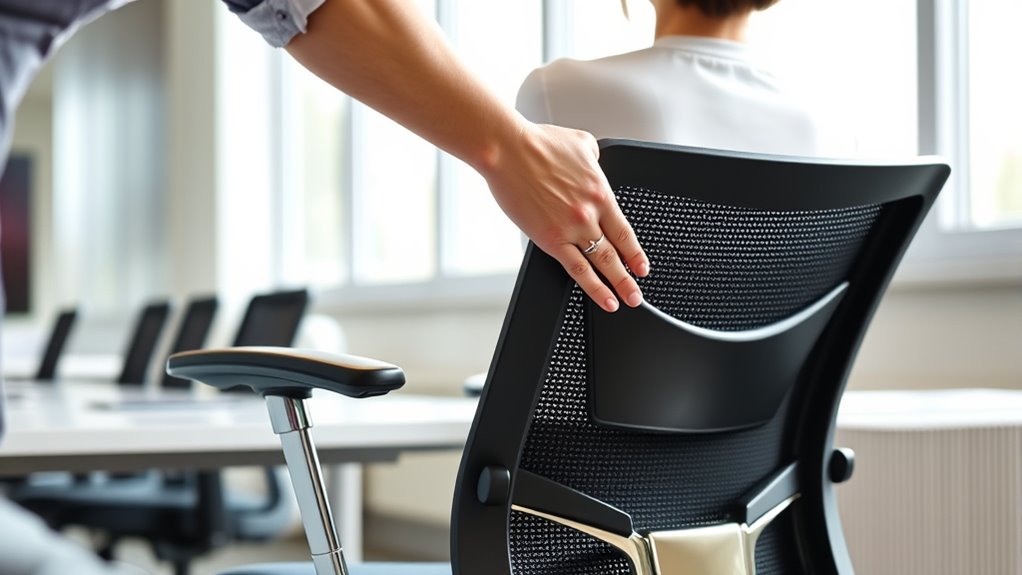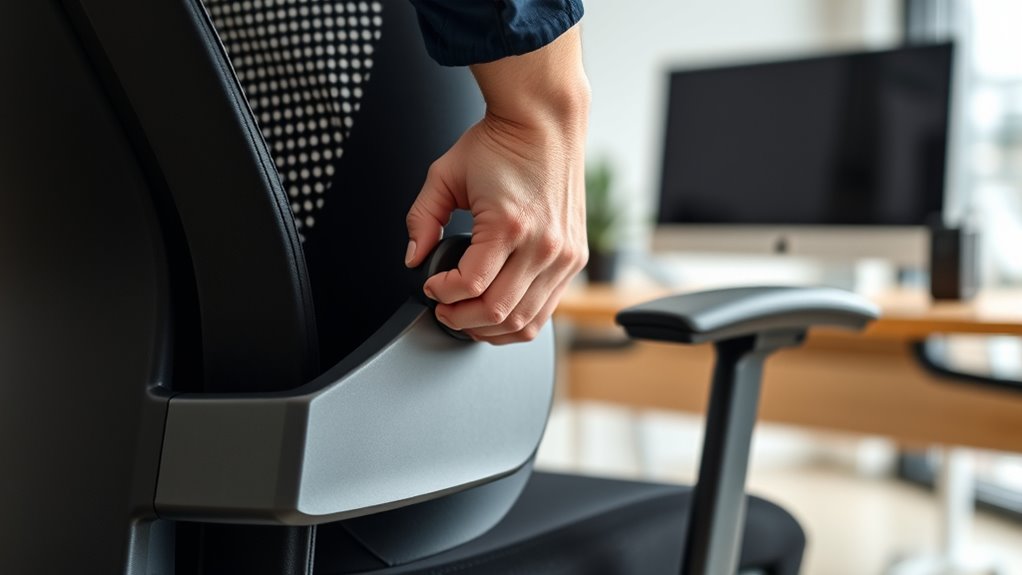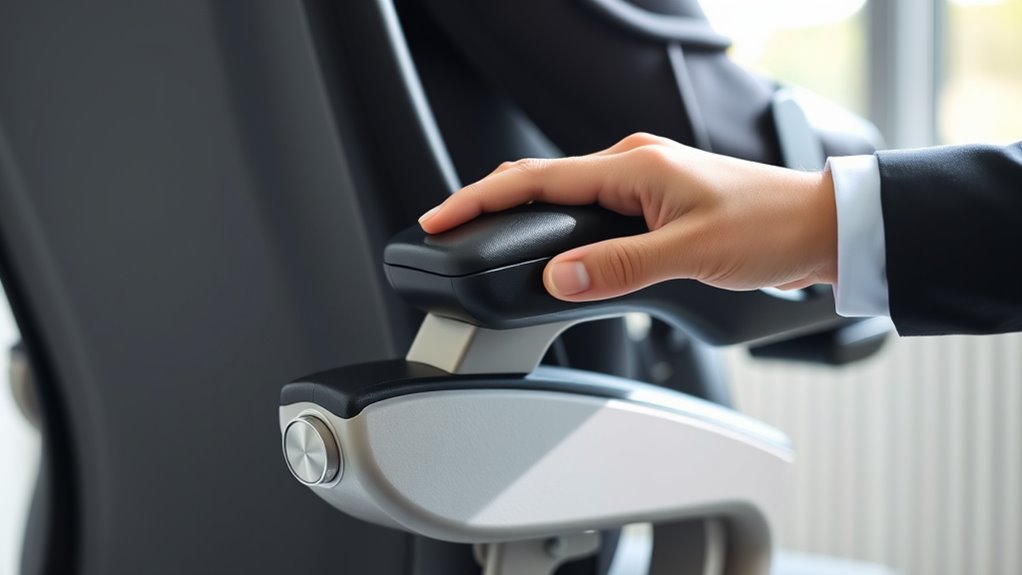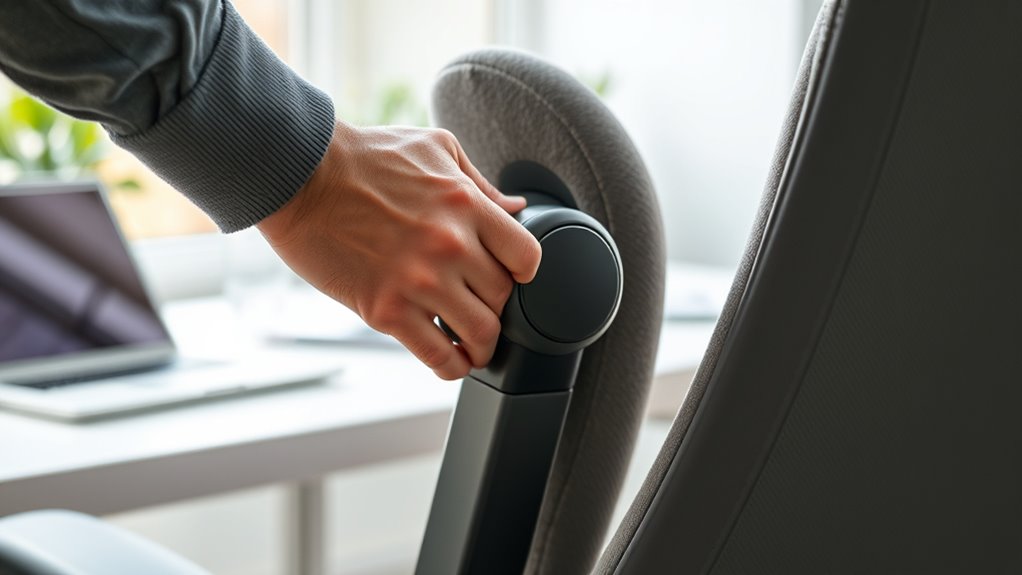To say goodbye to back pain, start by adjusting your seat height so your feet rest flat on the floor with knees at a 90-degree angle. Support your lower back with a properly positioned backrest and lumbar cushion, ensuring your spine stays aligned. Fine-tune your armrests for comfort and maintain good posture throughout the day. If you want detailed steps to perfect your setup and prevent long-term discomfort, keep exploring for more tips.
Key Takeaways
- Set your seat height so your feet are flat and knees are at a 90-degree angle for proper circulation.
- Adjust the backrest to support your lower and upper back, maintaining a slight recline of 100-110 degrees.
- Use lumbar cushions and align lumbar support with your spine’s natural curve for optimal comfort.
- Position armrests to keep elbows at a 90-degree angle, supporting arms without shrugging shoulders.
- Take regular breaks, stretch frequently, and keep ergonomic principles in mind to maintain long-term spinal health.
Assessing Your Current Chair Setup

Before making any adjustments, it’s important to evaluate your current chair setup to identify what might be causing your back pain. Start by checking your desk posture—are you leaning forward or slouching? Proper alignment helps reduce strain. Next, examine your chair materials; if your chair is too hard or too soft, it may not support your spine properly. Look at the seat padding and backrest—are they comfortable and supportive? If your chair lacks lumbar support or feels unstable, it could contribute to discomfort. Adjustments won’t help if your initial setup is off. Additionally, understanding the importance of contrast ratio in projectors can help you create an ideal viewing environment that minimizes eye strain and enhances visual clarity. Take note of how you sit and the materials of your current chair. This way, you can pinpoint what needs changing to improve your back health and create a more ergonomic workspace.
Adjusting Seat Height for Optimal Support

Adjusting your seat height is a crucial step in creating an ergonomic workspace that supports your back. When you set the right height, your feet should rest flat on the floor, and your knees should be at a 90-degree angle. This promotes proper circulation and reduces strain. Use the lumbar adjustment to guarantee your lower back is adequately supported; a well-positioned lumbar support helps maintain the natural curve of your spine. Consider your seat material as well—firm yet comfortable padding helps prevent pressure points and keeps you seated comfortably for longer periods. When your seat height is correct, you’ll experience less back fatigue and improved posture. Additionally, ensuring your workspace incorporates AI-driven security systems can help protect your data and workstation from digital threats. Take a moment to make these adjustments for a healthier, more supportive seating position.
Positioning Your Backrest for Comfort and Alignment

Positioning your backrest correctly is essential for maintaining proper spinal alignment and reducing back pain. Start by adjusting the backrest so it supports your lower and upper back comfortably, promoting good posture awareness. Your backrest should be slightly reclined, about 100-110 degrees, to prevent strain. Use ergonomic accessories like lumbar cushions if needed to fill any gaps and enhance support. Make certain the backrest supports the natural curve of your spine without forcing you into an awkward position. Regularly check your posture to avoid slouching or leaning forward. Proper positioning encourages comfort throughout the day and minimizes discomfort. Remember, a well-aligned backrest is a key step toward preventing chronic back issues and staying productive at work. Additionally, incorporating correct office chair ergonomics can further optimize your sitting posture and reduce fatigue.
Fine-Tuning Armrests and Lumbar Support

Fine-tuning your armrests and lumbar support guarantees your chair fits your body perfectly, reducing strain and promoting comfort. Start by adjusting the armrest alignment so your elbows rest comfortably at a 90-degree angle, preventing shoulder tension. Confirm the armrests are neither too high nor too low, supporting your arms without lifting your shoulders. Next, fine-tune the lumbar padding to provide adequate lower back support. The lumbar support should fill the natural curve of your spine, offering gentle pressure without causing discomfort. Adjust the lumbar height so it aligns with your lumbar curve, giving your back the support it needs during long hours. Proper armrest and lumbar support adjustments will help maintain proper posture and minimize back fatigue throughout your workday. Additionally, understanding ergonomic principles can further enhance your chair’s setup for maximum comfort and health benefits.
Incorporating Ergonomic Tips for Long-Term Relief

To achieve long-term relief from back pain, incorporating ergonomic habits into your daily routine is essential. Focus on proper feet positioning by keeping your feet flat on the floor or on a footrest to reduce pressure on your lower back. Guarantee your keyboard placement allows your elbows to stay close to your body and wrists in a neutral position, minimizing strain. Regularly take breaks to stretch and move, preventing stiffness. Consider these tips to improve your ergonomic practices:
Maintain proper feet placement, ergonomic keyboard positioning, and take regular breaks to prevent back pain.
- Maintain feet flat on the ground or footrest
- Position your keyboard at elbow height for comfort
- Incorporate short stretching routines throughout the day
Additionally, choosing the right office chair adjustments can significantly enhance your ergonomic setup and support spinal health.
Frequently Asked Questions
How Often Should I Adjust My Office Chair for Optimal Comfort?
You might wonder how often you should tweak your office chair—is it daily, weekly, or only when you feel like a pretzel? The truth is, doing a quick ergonomic check and a frequency adjustment every few days keeps things comfy. Regular adjustments prevent discomfort from creeping in, so make it a habit. Trust me, your back will thank you for staying proactive and avoiding that dreaded pain.
Can a Poorly Adjusted Chair Cause Long-Term Back Issues?
A poorly adjusted chair can definitely lead to long-term back issues, even if ergonomic myths suggest otherwise. If your office posture isn’t correct, you might strain your muscles and spine over time. You need to adjust your chair regularly to support proper alignment, preventing pain and injury. Don’t rely on myths—prioritize ergonomic principles to maintain good posture and protect your back in the long run.
What Signs Indicate My Chair Needs Immediate Adjustment?
Ignoring discomfort is like silencing your body’s posture cues, which signal your chair needs adjusting. If you experience persistent pain, tingling, or numbness, these are clear comfort feedback signs. Also, if you find yourself slouching or straining to reach your keyboard or screen, it’s time to adjust your chair immediately. Pay attention to these signs, and keep your posture aligned to prevent long-term issues.
Are There Specific Ergonomic Accessories Recommended for Back Pain Relief?
When seeking relief from back pain, ergonomic accessories can make a big difference. You should consider adding lumbar support cushions to maintain proper spine alignment and reduce strain. Ergonomic cushions also help distribute pressure evenly, keeping your back comfortable throughout long workdays. These accessories are simple to install and customize, providing essential support that promotes good posture and minimizes discomfort, helping you work more efficiently and pain-free.
How Can I Tell if My Chair Is Suitable for My Height and Weight?
You check if your chair suits you by adjusting the chair height to match your desk and make certain your feet rest flat on the floor. You verify the weight capacity to see if it supports your weight comfortably and securely. You test the armrests for proper height and the lumbar support for adequate back support. You make sure all adjustments feel natural and provide comfort throughout your workday.
Conclusion
By making these simple adjustments, you’ll sit more comfortably and reduce back pain. It’s understandable to worry about the time investment, but once you find the right setup, it becomes second nature. Remember, small changes can lead to big relief over time. Don’t let initial doubts hold you back—your improved posture and comfort are worth it. Start today, and enjoy a healthier, pain-free workday tomorrow.









